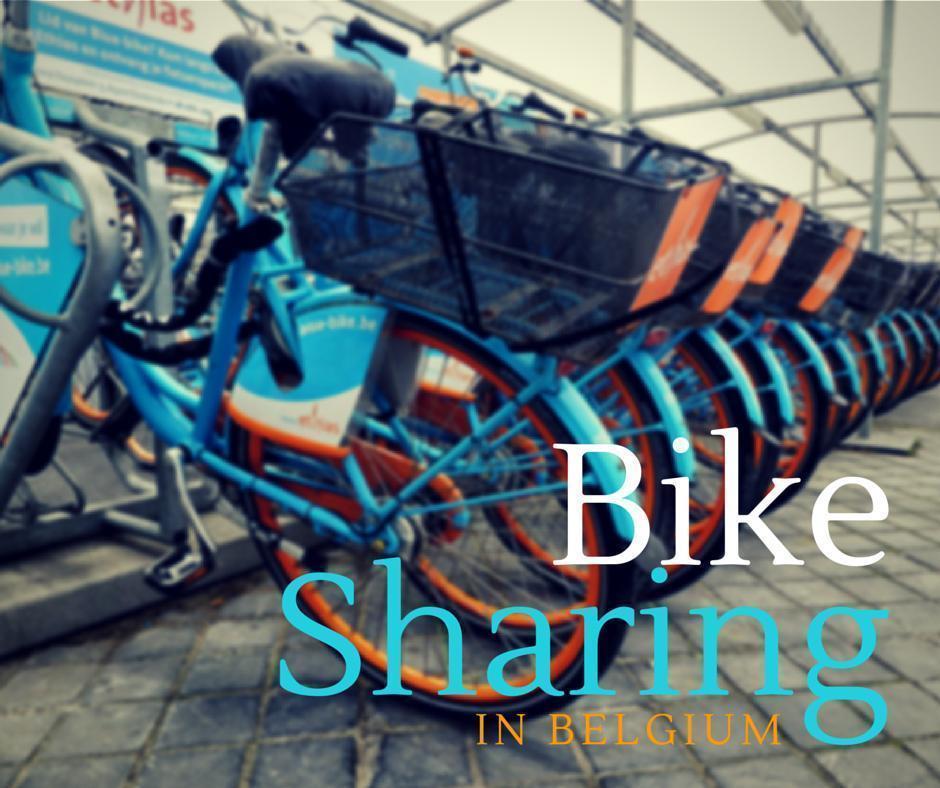
Today, guest contributor, Adrian, discusses bike sharing schemes around Belgium so you can explore the country by bike without the need for your own two wheels.
Last time, I gave you a step-by-step guide on how to take your own bicycle on the train, in Belgium. For some, this option is too expensive or too much hassle. But there’s no need to give up discovering this country by bike, as there are still a few interesting alternatives. Today I’m talking about bike sharing systems, which allow you to easily rent a bike and give you enough flexibility to enjoy the ride.
Of course, it is always possible to look for ordinary bike rental centers in touristic areas. You give your ID, pay a caution fee, and take a bike for a number of hours or days. However, this is still quite complicated and often more expensive than taking along your own bike. That’s why I would like to introduce you to the Belgian bike-sharing services. They are different from classic rental centers in that they are based on a subscription (annual, weekly or daily), they are mostly automatic, and they allow you to rent a bike for a very low fee – sometimes even for free. Therefore, you can enjoy them several times or even use them regularly, without having to spend time and money each time you take one.
There are four such services in Belgium, but they fit into two large categories: one nationwide bike sharing system and three local systems for three big cities. I will explain how they work, one by one.
Blue-Bike, Belgium’s nationwide bike sharing system
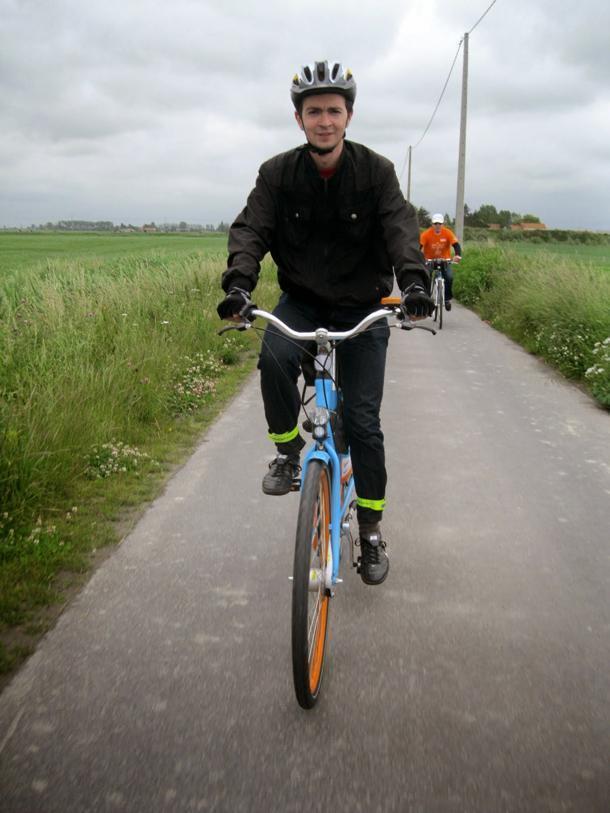
Rented in Ostend, ridden all the way to De Panne. It’s easy to sightsee Belgium by Blue Bike.
Managed by the national railway company SNCB, this service is designed to help railway travellers continue their journey from the station to their destination point, be it their workplace, a museum, a friend’s house, or a natural area not served by public transport. It is organized as a network of rental stations that lie next to train stations in about 40 Belgian cities.
In order to use this service, you must sign up for a subscription worth 10€/year. You can either do this online, and then wait for your membership card to be delivered by post, or you can visit one of 12 Bike Points (Point vélo in French, Fiestpunt in Dutch) during their opening hours to become a member right away. Also, a number of companies and organisations have partnered with Blue-Bike to offer extra facilities to their employees.
Once signed up, you can rent a bike from any of the 44 stations open all around Belgium. For every bike hire, you will pay a maximum 3€ for 24 hours. I say “maximum”, because this is the standard fee. In a growing number of cities, however, a deal has been signed with the authorities to subsidize the bike hire cost. Therefore, in some cities, like Bruges or Mechelen, you will only pay 1€/24 hours, while in others, such as Hasselt, Eeklo or Ottignies, you pay nothing for the first 24 hours.

Plenty of Blue Bikes available near many Belgian railway stations.
Renting and using a Blue Bike is very simple: you go to the automatic machine, pass your card on the reader, type in your PIN code and then you receive the key to your bike. The next step is to go to the bicycle rack and take the bike assigned to you. You can even rent two bikes with the same membership card, in case you are not travelling alone. Obviously, you will pay for both of them, according to the same local fare.
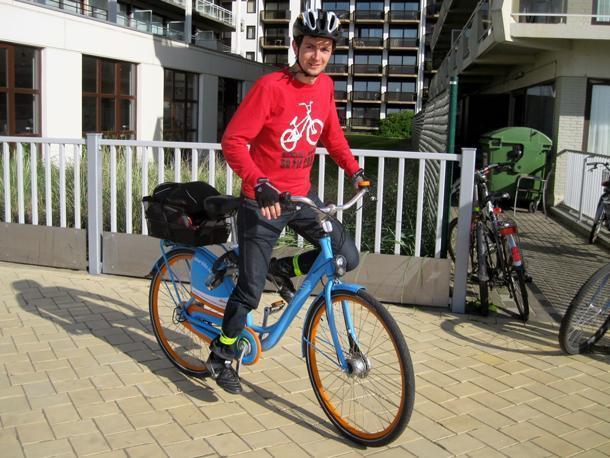
Blue Biking the Belgian coast
At the end of your ride, don’t forget to return the bike to the same station where you picked it up. Otherwise, a rather high fee of 10€ will be charged to your account.
In a few locations, electric bikes are also available, but under slightly stricter conditions. Don’t hesitate to check for all the information you need (bike rent locations, fares, payment methods, conditions) on the Blue Bike website.
| Blue-Bike Pros | Blue Bike Cons |
|
|
|
|
|
|
Villo!, Li bia vélo, Velo Antwerpen – the three city-bike sharing systems
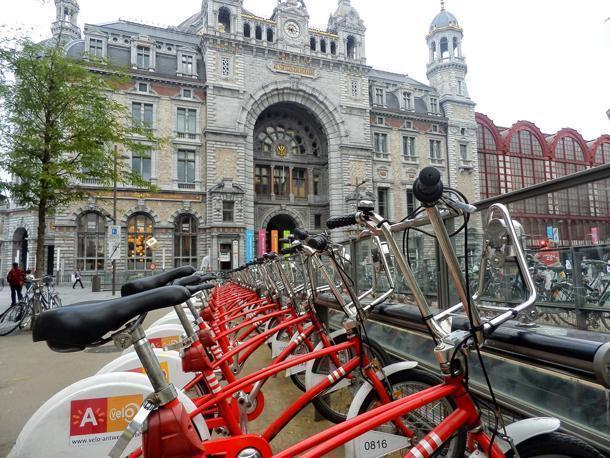
Antwerpen Velo city bikes waiting to be rented in front of Antwerp’s Central Station.
The other concept of bike sharing is the local one. Meant to serve only one city, it can be seen as a public transport system. In this case, you won’t take a bicycle and keep with you throughout the day. Instead, you will pick it up from a station, only to use it from point A to point B in the city. Then you will drop it off in another station and continue on your own way. Do you need to get further to point C? No problem. When you finish, you get back to the bike station and pick up another bike, ride it to your point C, and leave it at the nearest station to that point. It´s almost like taking a bus: you board and you get off at fixed bus stops and, once you get off, you don’t care anymore where it’s going. You don’t keep a bus waiting for you all day long. Instead, you’ll wait for another one, when you need to get elsewhere.
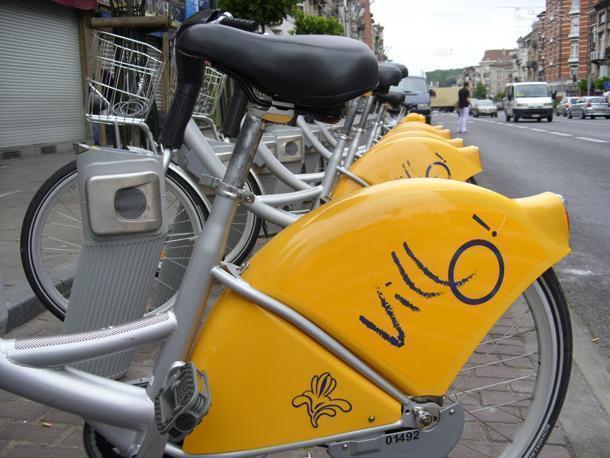
Villo! is Brussels’ bike sharing system.
Three cities in Belgium are served by city bike sharing systems: Brussels has Villo!, Namur has Li Bia Vélo and Antwerp has Velo Antwerpen.
All three networks are fully automatic. In these cities, bicycle stations are usually located hundreds of meters apart throughout the city (station maps are available on their websites or via their mobile apps). This way, you can find a bike and ride it virtually everywhere within the city limits.
In order to use such a bike sharing system, you either need a long term membership card (valid for one year) or a short term subscription (day or weekly pass). For the former, you can sign up online and pay by credit card. For the latter, different solutions are available, depending on the city. In Brussels and Namur, you can just go to an automatic machine (in most of the bike stations), where you can purchase your ticket using an accepted credit or debit card. An extra amount of money might also be temporarily blocked on your card, as a deposit (check the rates and conditions for each service). In Antwerp, this can be done online or at their Velo-desk during their office hours.

You can buy a daily or weekly pass at the terminals in most Villo! stations.
Any of these subscriptions allows you an unlimited number of bike hires, during their validity period.
As it is designed as a public transport system, the hiring conditions are different from Blue Bike. The first 30 minutes of each hire are free. This means that, if you only use these bikes for rides of under 30 minutes, no matter how frequently, all you pay for is the membership (yearly, daily or weekly). Otherwise, incremental rates are charged on top of your membership for every extra 30-minute slot. This is meant to discourage people from monopolizing a bicycle throughout the day.
The best practice, if you need to do longer trips, is to split them into less-then-30-minute rides. The worst possible practice is to keep a bike with you when you take a break (for example, when entering a shop). If you need to do anything that does not require you to ride that bicycle, then simply park it in the nearest station and get it (or another one) back when you need it. This way, your time counter is stopped and you won’t pay for your “break”.
Rates vary from one city to another, but here are the fares for the three Belgian systems in a glance:
Villo! (Brussels): 32,60€/year; 7,65€/week; 1,60€/day.
Li bia velo (Namur): 30€/year; 3€/week; 1€/day.
Velo Antwerpen (Antwerp): 37€/year; 9€/week; 3,8€/day.
All three systems practice similar rates for rides longer than 30 minutes: 0,50€ for the 30-60 minute time interval and 1€ for the 60-90 minute interval. However, it is always best to check these rates and all the terms of use beforehand, on their respective websites.
| City Bike Sharing Pros | City Bike Sharing Cons |
|
|
|
|
|
|
If you plan on travelling further, note similar systems can be found in many European cities, including Paris, Lille and Luxembourg (to name just three).
Now you have knowledge of a good transportation alternative if you want a less expensive and more flexible way to move around. In the end, summer is already here so… enjoy your rides!

Like this article? Save it to Pinterest!
- BANAD Festival – Visit Brussels Art Nouveau and Art Déco Masterpieces - May 16, 2018
- A Spring Blossom Cycle Tour of Hageland, Belgium - May 8, 2018
- A Classic Car Tour of Hageland, Belgium with WOW-Routes - May 1, 2018
- Cycling Around Brussels: Discover the Hidden Gems of the Green Belt in Flemish Brabant, Belgium
- A Bicycle Tour of Brussels’ Secret Gardens with Pro Velo
- A Beginner’s Bicycle Trip in Belgium from Namur to Dinant
- How to Take Your Bike On Belgian Trains – A Step-by-Step Guide
- Bike Sharing in Belgium
- Bike through Belgium’s Hidden Gems with Le beau vélo de RAVeL
- A Spring Blossom Cycle Tour of Hageland, Belgium
